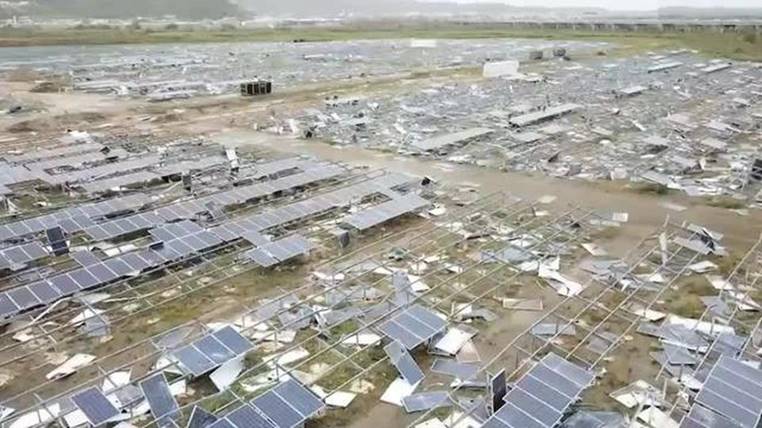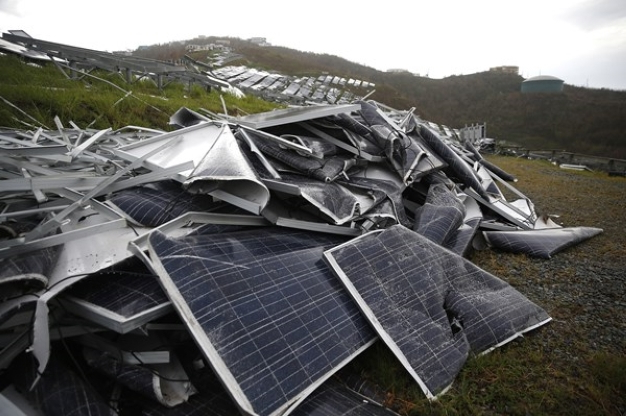Because solar panels can’t be economically recycled, millions upon millions of them are headed for landfill. Around the globe, countless millions of panels have already reached their use by dates. Over the next decade millions of tonnes of them are headed for the dump.
Each panel is a veritable toxic cocktail of gallium arsenide, tellurium, silver, crystalline silicon, lead, cadmium and other heavy metals. As the stuff leeches into the water table, it’s not difficult to imagine the effect on water supplies, the environment and human health.
But, as Collister Johnson details below, it’s not as if either the rent-seekers behind the solar scam, or the relevant responsible authorities that run cover for them, could care less.
Spotsylvania’s solar decommissioning will be a nightmare
Culpeper Star-Exponent
Collister Johnson
10 June 2021
In March 2019, the Spotsylvania County Board of Supervisors granted sPower, a Utah-based developer of industrial solar facilities, a Special Use Permit (SUP) to construct a 6,300-acre solar factory on land lying just outside Fredericksburg. The vote was 5-2, with only Supervisors David Ross and Paul Trampe voting against it.
This massive facility—dubbed the “Spotsylvania Solar Energy Center”—is one of the largest in the U.S., and by far the largest such facility east of the Mississippi River. When it is finished, it will contain over 1.5 million solar panels, each weighing about 40 pounds, and all of them containing toxic chemicals, such as cadmium telluride, copper sellenide, and lead.
The action of the board was puzzling for many reasons. Just over one month before, the Spotsylvania County Planning Commission had voted against the application by a 5-2 margin, yet the Board of Supervisors overturned that finding by a 5-2 vote.
Furthermore, the Board of Supervisors took no expert testimony or held evidentiary hearings to justify such an enormous facility. Nor did it take any testimony addressing the issue of the removal of the solar panels once they have outlived their useful lives (called “decommissioning”), which for panels of this type is usually 15-20 years.
It should have.
The removal and disposition of these panels will be a monumental task, one that is even more complex and challenging than the original installation itself.
Virginia has a law governing the decommissioning of industrial solar facilities (as opposed to the more common and considerably smaller rooftop solar installations). The law states that “a locality” in which the solar facility is located “shall require” the developer of the facility to provide a “financial assurance” to guarantee that funds are available to properly decommission the project.
So what did the Board of Supervisors require sPower to provide in the way of a financial assurance? After all, the decommissioning will require the removal of over 30,000 tons of toxic waste. Surely the board would take great pains to ensure that this part of the project would be properly paid for, and that funds would be secured to finance the decommissioning in case of default by the developer.
This is where the board’s arrangement with sPower becomes very curious.
Instead of requiring financial assurance, as mandated by Virginia law, the Board of Supervisors agreed to a scheme where no assurance whatsoever would be required for the first five years of the project, and no assurance covering the full cost of decommissioning would be required until the 30th year of the project, even though the useful life of the solar panels is only 15-20 years.
But the real problem with the decommissioning scheme is even worse than that. The board was somehow persuaded to agree that the cost of decommissioning would be reduced—“offset” is the term used—by the salvage value of the solar panels installed on the property.
What was that again? Spotsylvania County does not own the panels or have any other property rights in the solar equipment installed for the project. Once the used equipment is sold, the county receives no proceeds. The county could care less what the salvage value of the property actually turns out to be.
In other words, the salvage value of the equipment is irrelevant to the cost of decommissioning. But in tying the two together, the county not only assumes salvage value risk, but also assumes this risk for solar property which it does not even own.
It would be like selling your house to a buyer, and letting the buyer agree to pay you for the house at the end of 30 years, with the sales price reduced by the salvage value of the furniture placed by the buyer inside the house.
In short, what Spotsylvania is facing is a potential Superfund cleanup site a few decades from now, with no cash money in escrow to finance the operation. sPower has not provided any financial assurance, as required by law, and the county is left with a bare promise that some entity owning the facility 30 years from now will comply with the decommissioning obligation, which raises the clear specter of protracted negotiation and litigation.
What was the Spotsylvania Board of Supervisors thinking?
Culpeper Star-Exponent



I caught sight of a solar farm on a day trip to see the fall splendours in a region known as one of Ontario’s most scenic tourist destinations. I was shocked to see how derelict it looked.
sPower is the company behind the behemoth project where the Navajo County and Cococino County boards of supervisors approved installation of 750 foot tall skyscraper wind turbines in pristine areas at Chevelon Canyon south of Winslow Arizona covering a whopping 49 square miles. The O’Haco Cattle Company is major land owner and political influencer in the area. It also has a project called Hot Air where the Navajo County lock step just approved the wind speed towers which precedes these projects. They are planning to cover massive areas with these monstrosities making that beautiful area an industrial camouflage puke green energy use and abuse nightmare. This affects the Chevelon Ranch, Chevelon Acres, Chevelon Retreat and Apache Sitgreaves forest. The drive into the forest from Winslow will be through a forest of these ugly energy inefficient mechanisms. They suck our energy and do not give enough back. The rich investors all know this that is why Warren Buffet stated he only invests in them because the public pays for them with subsidies. He just collects the money. These renewables are well proven wastes of energy. They only renew usage of rate payers and tax payers funds to pour into the portfolios of the rich. They are now completely ruining the landscapes everywhere. Humanity has to get a grip on this endless expansion of wasteful industries and wasteful transfers of energy.